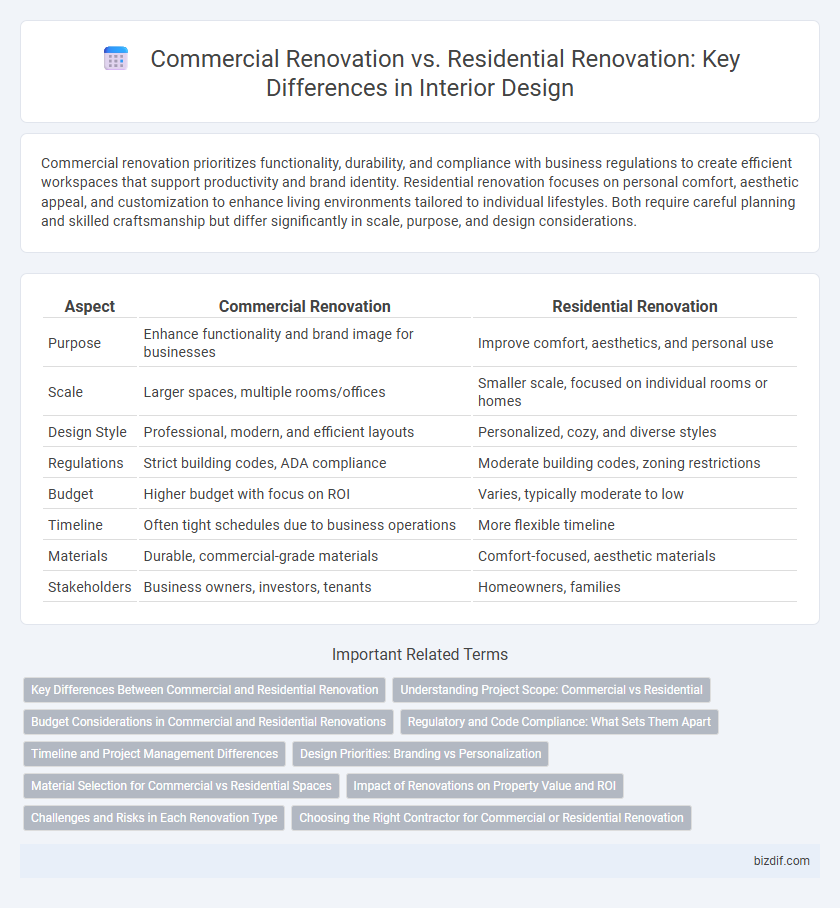Commercial renovation prioritizes functionality, durability, and compliance with business regulations to create efficient workspaces that support productivity and brand identity. Residential renovation focuses on personal comfort, aesthetic appeal, and customization to enhance living environments tailored to individual lifestyles. Both require careful planning and skilled craftsmanship but differ significantly in scale, purpose, and design considerations.
Table of Comparison
| Aspect | Commercial Renovation | Residential Renovation |
|---|---|---|
| Purpose | Enhance functionality and brand image for businesses | Improve comfort, aesthetics, and personal use |
| Scale | Larger spaces, multiple rooms/offices | Smaller scale, focused on individual rooms or homes |
| Design Style | Professional, modern, and efficient layouts | Personalized, cozy, and diverse styles |
| Regulations | Strict building codes, ADA compliance | Moderate building codes, zoning restrictions |
| Budget | Higher budget with focus on ROI | Varies, typically moderate to low |
| Timeline | Often tight schedules due to business operations | More flexible timeline |
| Materials | Durable, commercial-grade materials | Comfort-focused, aesthetic materials |
| Stakeholders | Business owners, investors, tenants | Homeowners, families |
Key Differences Between Commercial and Residential Renovation
Commercial renovation projects prioritize functionality, compliance with building codes, and accommodating higher foot traffic, often involving large-scale structural modifications and specialized HVAC systems. Residential renovations focus on enhancing comfort, aesthetics, and personal lifestyle preferences, typically featuring custom finishes, open layouts, and energy-efficient upgrades. Budget, timeline, and permit requirements significantly differ, with commercial renovations demanding more extensive planning and adherence to safety regulations.
Understanding Project Scope: Commercial vs Residential
Commercial renovation projects typically involve larger-scale transformations with stricter regulatory requirements, including ADA compliance and fire safety codes, while residential renovations focus on personal living spaces with attention to aesthetic preferences and functionality. Understanding project scope in commercial settings requires detailed coordination among multiple stakeholders such as architects, contractors, and business owners, often emphasizing workspace optimization and brand identity. Residential renovation scope prioritizes enhancing comfort, energy efficiency, and customized design elements to reflect the homeowner's lifestyle.
Budget Considerations in Commercial and Residential Renovations
Budget considerations in commercial renovations typically involve higher costs due to the need for compliance with stricter building codes, accessibility standards, and specialized materials tailored for heavy usage. Residential renovation budgets often prioritize aesthetic upgrades and personal comfort, with flexibility in choosing materials and design elements based on homeowner preferences and lifestyle. Understanding the scope of work, scale, and regulatory requirements is essential to accurately estimating expenses and managing costs effectively in both commercial and residential renovation projects.
Regulatory and Code Compliance: What Sets Them Apart
Commercial renovation projects must adhere to stringent regulations and building codes, including ADA accessibility standards, fire safety, and energy efficiency requirements, which are often more complex than those for residential renovations. Residential renovations focus primarily on local zoning laws, basic safety codes, and habitability standards, with less emphasis on public access and large-scale occupant safety. The differences in regulatory frameworks significantly impact project planning, permitting processes, and design decisions in commercial versus residential interior design renovations.
Timeline and Project Management Differences
Commercial renovation projects typically have shorter, more rigid timelines driven by business needs, requiring precise scheduling to minimize operational downtime. Residential renovations allow for more flexible timelines, accommodating the homeowner's schedule and lifestyle preferences, often with less stringent deadlines. Project management in commercial renovations demands coordination with multiple stakeholders and compliance with industry regulations, whereas residential projects focus more on personal design preferences and homeowner communication.
Design Priorities: Branding vs Personalization
Commercial renovation emphasizes branding through cohesive color schemes, logos, and thematic elements that reinforce corporate identity and customer experience. Residential renovation prioritizes personalization by incorporating homeowners' tastes, lifestyle needs, and comfort preferences to create unique living spaces. Design choices in commercial projects focus on functionality and brand consistency, while residential designs highlight individual expression and adaptability.
Material Selection for Commercial vs Residential Spaces
Material selection in commercial renovation prioritizes durability and compliance with safety regulations, often utilizing high-grade, low-maintenance materials like vinyl flooring, metal fixtures, and fire-resistant wall panels. In residential renovation, the emphasis is on comfort, aesthetics, and personalization, with natural wood, soft textiles, and eco-friendly paints commonly chosen to create a warm and inviting atmosphere. Both projects require careful consideration of functionality and design, but commercial spaces demand materials that withstand heavy use and meet strict building codes.
Impact of Renovations on Property Value and ROI
Commercial renovation projects typically yield higher returns on investment (ROI) due to their potential to attract premium tenants and increase rental income, significantly boosting property value. Residential renovations often enhance curb appeal and livability, leading to moderate increases in property resale value, particularly through kitchen and bathroom upgrades. Understanding market demand and aligning renovations with property purpose is crucial for maximizing ROI in both commercial and residential settings.
Challenges and Risks in Each Renovation Type
Commercial renovation projects often face challenges related to strict regulatory compliance, tight project timelines, and the need to minimize business disruption, increasing risks such as cost overruns and delayed occupancy. Residential renovations typically involve risks tied to personal preferences, evolving design trends, and unforeseen structural issues, which can lead to scope creep and budget inflation. Both renovation types demand careful planning, effective communication, and risk management strategies to ensure successful project outcomes.
Choosing the Right Contractor for Commercial or Residential Renovation
Choosing the right contractor for commercial or residential renovation hinges on their expertise in handling project-specific demands such as scale, compliance requirements, and timelines. Commercial renovation contractors often possess specialized knowledge in zoning laws, safety codes, and minimizing business downtime, while residential contractors excel in creating personalized, comfortable living spaces that align with homeowners' aesthetics and budgets. Evaluating previous projects, certifications, and client reviews helps ensure alignment with either commercial or residential renovation goals for a seamless remodel.
Commercial Renovation vs Residential Renovation Infographic

 bizdif.com
bizdif.com